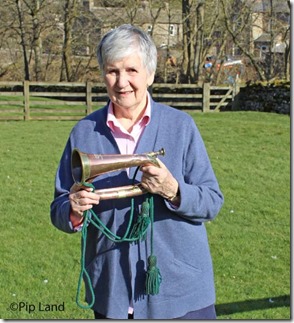The Leyland family of Wensleydale have links with the Battle of Waterloo, World War 1 and World War 2. John “Peter” Leyland‘s widow, artist Janet Rawlins, lent a bugle to Askrigg village for their commemoration of the start of World War 1. She commented afterwards:
“It was an amazing and very moving occasion – huge crowd all with lanterns, a still evening, Christine (Hallas) explained about James Preston and Mary Rose read a poem. The bugler blew, standing up on the cross (I cried my eyes out – doubt if it had been blown like that since Jim Preston). The King’s Arms provided free whisky for all – and a piper played. The church was full of candles and the two brass vases in memory of James Preston and another were filled with poppies.”
James Graham Preston of West End House, Askrigg, was a member of Askrigg church choir, a Sunday School teacher and a pupil teacher at Askrigg day school. He then attended the Beckett Park Teacher Training College at Leeds with his cousin, Dick Chapman, and won several awards for swimming and running.
He volunteered for the Army in 1915 and twice turned down a commission preferring to remain a private. He transferred from the Royal Field Artillery and became a bugler with the 18th Battalion Lancashire Fusiliers. On his 20th birthday on October 22, 1917, the Battalion was pinned down by enemy fire in the Houthulst Forest in the Ypres Salient. Preston’s lung was pierced by a bullet and he died in hospital on November 2.
His bugle was returned to West End House and is now in the care of Janet as her late husband, Peter, was James Preston’s nephew.
The bugle has been part of the peace and remembrance display at the Bainbridge Quaker Meeting House which is open from 10.30am to 12.30pm on Wednesdays. Messages can be left on the Peace and Remembrance Wall outside.
The first Wensleydale men to be killed during WWI were: Pvt Frederick Cockett from Hawes on October 29, 1914; Capt Hugh C Chaytor from Spennithorne on October 31 (both in and around Ypres); Lt Commander Percival van Straubenzee of Spennithorne, when his ship was blown up during a battle with German cruisers off coast of Chile on November 1; and Leading Stoker John R Leake from East Witton on November 3, whose submarine hit a German mine after protecting Great Yarmouth from an attack by German cruisers. Information about these men and James Preston from Wensleydale Remembered by Keith Taylor.
Peter’s father, John, (1890-1942) attended Ackworth School and became firmly convinced of the Quaker principles taught there. These became his way of life and when World War I began he registered as a conscientious objector and joined the Friends Ambulance Unit (FAU).
In France he was a member of SSA (Sections Sanitaires Anglaises) 14. Below – John with his ambulance.
But to many in his home village of Bainbridge John Leyland was just another “skiving” conscientious objector. It therefore came as a big surprise to them to hear, at his funeral, that he had been awarded the Croix de Guerre for his bravery. (95 other members of the FAU also received the Croix de Guerre including a nurse.Five convoy members were killed ‘in action’.)
John earned the Croix de Guerre by continuing to drive ambulances to the front line to collect the injured even when the road was being shelled.
“One day he could see shells popping up the road towards him As they got nearer he hopped out into the ditch and the next shell hit his ambulance,” Peter said.
(Left) John Leyland’s ambulance after it was hit. Photo belongs to J Leyland.
See also Peter Leyland’s story of his experiences with the FAU China Convoy in World War II. And for details of the family’s connection with the Battle of Waterloo see Peter Leyland and the Tipladys.


